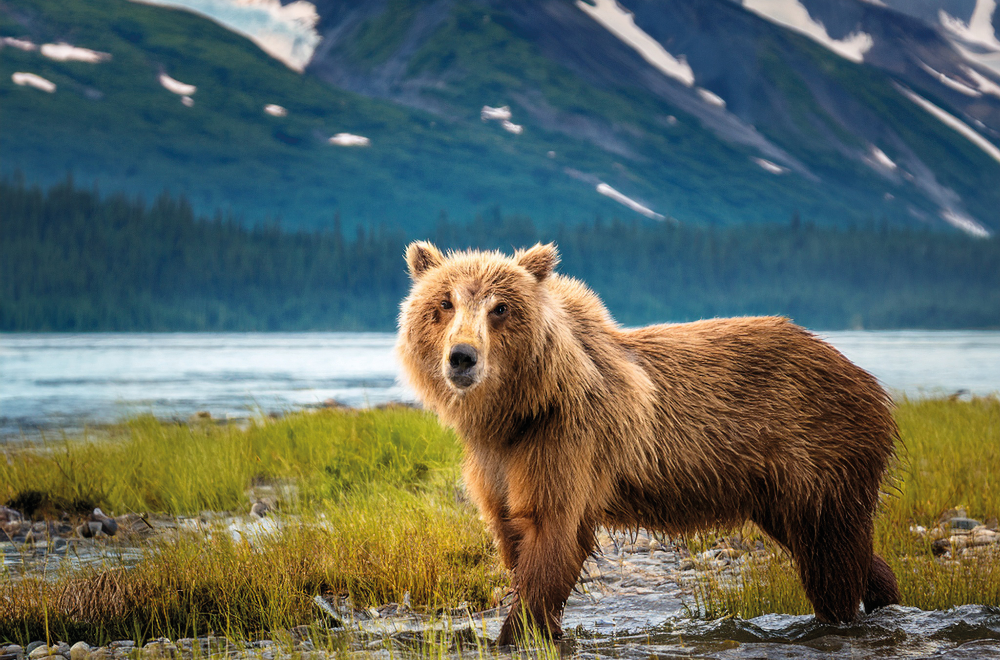
Buzun Ötesinde: Alaska’da Yaşam ve Kültür
Buzun Ötesinde: Alaska’da Yaşam ve Kültür
“Buradaki hava adeta mucizevî, etrafınızı fısıltı gibi bir büyüyle sarar.”— Robert Service, Yukon’un Şairi
*
Derler ki Alaska’da toprak konuşur.Ben diyorum ki, şarkı söyler.
Denali’nin eteklerinde bir kulübede odun ateşinin çıtırtısında, bir Tlingit dansının yumuşak davul vuruşlarında, karla örtülü bir vadide yankılanan bir kurdun ulumasında... Alaska yalnızca bir rota değil — gerçek bir nefes. Bir ritim, bir yaşam biçimi. Bu topraklarda yaşayanların kalbinde yer etmiş bir sınır hattı.
Sizi buzullardan öteye, Kuzey’in ruhuna götüreyim.

İlk Halklar: Ataların İzinde Yaşayan Bilgelik
Altına hücumcular, denizciler, kaşiflerden çok önce Alaska'nın gerçek sahipleri vardı: Tlingit, Haida, İnupiat, Yup’ik ve Athabaskan halkları — doğaya ve atalara derin bir saygıyla kök salmış kültürler.
Ketchikan yakınlarında bir Tlingit topluluğunda hikâye anlatımına tanıklık ettim. Oyma totemlerin gölgesinde, yaşlılar yüzyıllardır aktarılan efsaneleri anlattılar. Bunlar yalnızca masallar değil, aynı zamanda bellek haritalarıydı: doğayı, yıldızları ve yaşamı anlatan şiirsel bilgiler bütünü.
“Biz hikâyeleri eğlendirmek için değil, kim olduğumuzu unutmamak için anlatırız.”— Glacier Bay’de bir Tlingit büyüğü
Görülmesi gerekenler: Totem Bight Devlet Parkı, Anchorage Alaska Yerli Kültür Merkezi

Uzak Yaşam: Kendi Kendine Yeterliliğin Sanatı
Alaska’da uzaklık bir zorluk değil — bir gurur nişanı.
Homer yakınlarında, kendi elleriyle inşa ettikleri bir kulübede yaşayan bir çiftle tanıştım. Güneş panelleri, sera, gökyüzüne açılan bir manzara… Burası Wi-Fi yerine yıldızlarla bağlı olduğunuz bir dünya. Somon nasıl tütsülenir, huş ağacından nasıl çay yapılır, rüzgâr nasıl dinlenir — hepsini öğrendim.
Hayat burada sadece "hayatta kalmak" değil, doğayla ortak yaşam. Geyik avcılığı, kürk işçiliği, el yapımı kayaklar — hepsi yaşamın birer dansı.
“Alaska’da komşun 160 km ötede olabilir, ama kar fırtınasında yardıma ilk o gelir.”
Vahşi Komşular: Devlerle Aynı Doğayı Paylaşmak
Alaska’da vahşi yaşamı aramanıza gerek yok. Zaten o hep oradadır.
Katmai Ulusal Parkı’nda bir sabah, bir anne boz ayının yavrularına balık tutmayı öğrettiğini izledim. Yakınlık, doğallık, gücün içindeki zarafet... Bir başka gün, Anchorage sokaklarında özgürce dolaşan bir mus gördüm — sanki şehrin gerçek sahibiymiş gibi.
Kartallar market tabelalarında yuva kurar. Kurtlar sisli ormanlardan geçer. Balinalar sahile selam verir. Burada hayvanat bahçesi yok. Çünkü siz onun içindesiniz.
Karşılaşabilecekleriniz:
Boz ve kara ayılar
Muslar, karibular, dağ keçileri
Orkalar ve kambur balinalar
Penguen benzeri puffinler, kel kartallar, su samurları
Kış Hayatı: Karanlığın İçinde Işık Aramak
Evet, Alaska’nın kışları uzun ve derin. Ama aynı zamanda ışıltılı.
Fairbanks’te üç gece boyunca kuzey ışıklarının peşinden gittim. Termal kıyafetler içinde, kar altında, gökyüzüne büyülenmiş halde… Yerel halk, ışıkların hikâyelerini paylaştı: "Çocuklara fısıldayan auroralar", "ataların dansı"…
Karanlık aylarda bile topluluklar canlı: buz festivalleri, köpek kızakları yarışları, sıcak kaynak partileri… Küçük bir kulübede sauna, ardından karın içine atlamak — hem çılgınca hem de doğru hissettiren bir gelenek.
“Soğuğu sevmezsin çünkü kolaydır; soğuğu seversin çünkü ardından gelen sıcaklık unutulmazdır.”

Kuzeyin Sanatı: Ruhla İşlenmiş El Sanatları
Alaska sanatı her zaman kusursuz değildir — çünkü samimidir. Doğaya, kimliğe, geçmişe bağlıdır.
Sitka’daki bir galeride, büyükbabasından kalan keskiyle sedir maskesi oyan bir Haida sanatçıyla tanıştım. Nome’da boncuk işlemelerinde yüzyıllık motifler gördüm. Her köyde, her elde bir hikâye vardı: örme sepetler, kemikten heykeller, balina dişinden takılar…
Mutlaka görülmeli: Anchorage Müzesi'nin kültür bölümü — Alaska’nın ruhuna açılan bir pencere.
Alaskalılar Ne Diyor?
Her karşılaştığım kişiye aynı soruyu sordum: “Neden Alaska?”Aldığım yanıtlar hep farklıydı ama bir o kadar gerçekti:
“Çünkü başka hiçbir yerde bu kadar canlı hissetmezsin.”“Çünkü burada gökyüzü gerçekten önemli.”“Çünkü vahşi doğa sana kim olduğunu yeniden öğretir.”
Son Bir Not
Alaska sadece gidilecek bir yer değil; sizi yeniden tanımlayan bir yer.
Dağlar zamanın öncesinden kalma. Hikâyeler kitaplardan daha derin. Sessizlik, bir metropolün gürültüsünden daha yüksek sesle konuşur.
Kolay değildir. Her zaman nazik de değildir.Ama Alaska sizi içine alırsa… ruhunuzun bir yerine kazınır.
Ve bir kez oraya ait hissettiniz mi… bir daha tam anlamıyla geri dönmek istemezsiniz.
ÖNEMLİ KÜLTÜREL ÖNERİLER:
En özel deneyimler: Yerli hikâye geceleri, somon tütsüleme atölyesi, kuzey ışıkları izleme, vahşi yaşam kulübeleri
Tatmanız gereken lezzetler: Ren geyiği sosis, tütsülenmiş somon, yaban mersini reçeli, kızarmış yerli ekmeği
Zamanlama: Ağustos sonu – Ekim başı (altın renkli ormanlar + aurora sezonu)
Yanınıza alın: Merak, kat kat kıyafet, su geçirmez bot, açık bir yürek
KUZEYİN SESLERİ
Alaska’nın Ruhuna Bir Bakış — Kendi Sözleriyle
“Sen Alaska’yı seçmezsin. O seni seçer.”— Maggie R., Nome
“Burada mesafeyi mil ile değil, saatle — bazen de kahve ile ölçersin.”— Dale K., Talkeetna
“Burası yolun sonu değil. Yol burada nehre, nehir gökyüzüne dönüşür.”— Tina Q., Sitka
“Yalnızlıkla tek başınalık farklı şeylerdir. Burada öğrenirsin.”— James H., Denali
“Soğuk kalabalıkları uzak tutar. Biz böyle seviyoruz.”— Ruth S., Fairbanks
ALASKA DİLLERİ
Alaska’da 20’den fazla yerli dil konuşuluyor.En yaygın olanlar:
Tlingit
Yup’ik
Inupiaq
Dena’ina Athabaskan
** Tlingit atasözü: "Gunalchéesh."
(Teşekkür ederim — ama bundan da fazlası: yürekten gelen minnettarlık.)
Bugün, yerel topluluklar ve okullar bu dilleri hikaye anlatımı, dijital arşivler ve müzik yoluyla canlandırmak için çalışıyor. Şanslıysanız, bunların bir ateşin etrafında söylendiğini bile duyabilirsiniz.